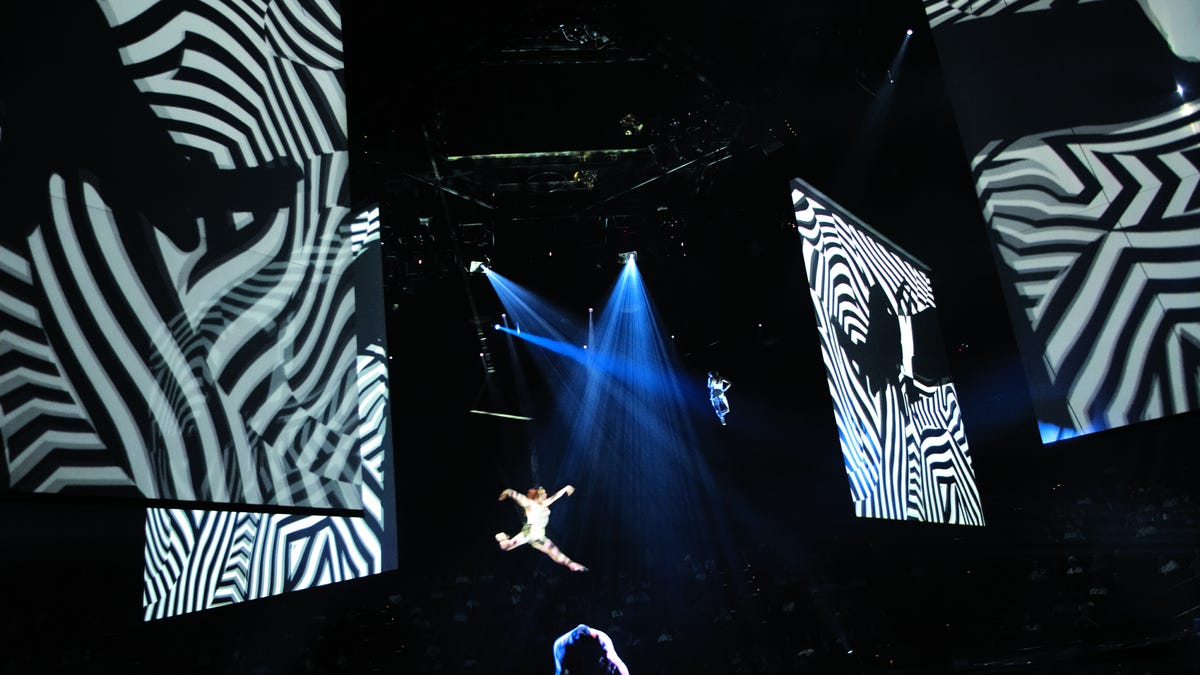For fifth birthday, Cirque reveals more 'Love' secrets
"Love," Cirque du Soleil's celebration of The Beatles at The Mirage Hotel and Casino in Las Vegas, is marking its five-year run this month with a series of special events, including a fresh peek backstage.

LAS VEGAS--"Love," Cirque du Soleil's successful celebration of The Beatles, is five years old this month.
Now that the show has reached this milestone, Cirque du Soleil is willing to unveil more of its secrets. Last week, Tom Wegis, technical director for "Love," served up an all-access, stat-soaked, guided tour of the show's backstage world now it's had five years to settle and grow into its surroundings. "Love" is the only Las Vegas Cirque du Soleil show performed in the round, and the three-level theater seats 2,013 visitors, all within 98 feet of the stage. The space has four control booths positioned in four separate corners (controlling lighting, projection, stage management, and automation, respectively). A total of 276 separate production cues flow back and forth between the booths as the show comes together.
Four automated tracks built into the stage carry artists and smaller stage pieces out into the show. The theater has 10 12,000-lumen projectors for each of two 2,000-square-foot panoramic screens wrapping around the space. Four 832-square-foot semi-transparent screens move in and out of the space, thanks to eight motors. They're illuminated by four 16,000-lumen projectors offering images of The Beatles and their music.
The most impressive machinery powering "Love" from behind the scenes resides under the stage. Nine stage lifts raise and lower artists and set elements in and out of the performance space. The largest motor-driven rack-and-pinion lift raises a center stage segment weighing about 22,000 pounds. Engineers dug 32 feet down into the desert ground to install it; it provides a force of 150 pounds per square foot and can raise the huge stage at a speed of a foot per second.
All Cirque productions stress that the safety of the artists and crew is the primary concern. To that end, the larger set elements are monitored by a specially designed encoder system that confirms that the moving piece is precisely where it needs to be when it needs to be there. If anything onstage strays by so much as millimeters, the movement cuts out and the show stops.
If a less serious problem arises in the show, the crew has invented a secret code to alert the cast and staff.
"If you see the show, and you hear the classic Beatles line--the repeated chant of 'number nine, number nine,' that's the code that something needs to be corrected," Wegis said. "Whatever the technical problem is is fixed as the show continues. But we have to stop the show if any element goes out of position. Safety is everything for Cirque du Soleil, no matter what show you're seeing."
In the rafters grid 87 feet above the stage and the audience, eight automated tracks and trolleys run from one end of the theater space to the other. They can simultaneously move 24 props, set elements, or performers and provide the production with 140 different ways to send a performer into the air. The trolley system is dexterous enough to act as a massive puppeteer of huge paper creations during the show's "While My Guitar Gently Weeps" number.
Related links
• Cirque du Soleil's new 'Iris' blooms in Hollywood
• Cirque du Soleil's Ka needs network technicians
• The Cirque du Soleil fights for radio frequencies
• Cirque du Soleil chief outlines 'poetic' space mission
The theater also utilities a ventilation system that can alter the temperature, density, and even the scent within the space. For example, during the Eastern meditation-themed "Here Comes the Sun" segment, the theater smells of flowers and faint incense. During the show, artists use a fiberglass piano filled with a soapy solution to send huge dancing bubbles around the theater. The designers quickly realized the dry desert air of Las Vegas was unfriendly to soap bubbles, so the ventilation system controls the density and airflow in the theater to make the dance possible.
Amid all of this movement and technology, Wegis revealed a special secret during the tour. Near the sound-mixing offices backstage, an elevated, black-walled vault sits tucked away--a chamber hiding in plain sight. If Wegis didn't point it out, no one would ever see it. But it's one of only two places on Earth where every Beatles track is housed.
"The original tapes are still stored at Apple Records in the U.K.," Wegis said. "But when George Martin and his son did the remix for the show, the trackers were carefully digitized for mixing. We have the direct digital versions of every track stored here. The vault is climate-controlled and has a waterless fire suppression system. Only a few of us can get access to that room."
As the tour wrapped up, the most surreal aspect of this backstage world became clear. When the tour concludes, the backstage exit opens out onto the casino floor. You step from the world of "Eleanor Rigby" and "A Day in the Life" out into the neon-lit world of hard-core Vegas. The massive "Love" stage and all of the engineering behind it hides behind the casino facade, providing a musical escape from the hyperactive hedonism around it.

